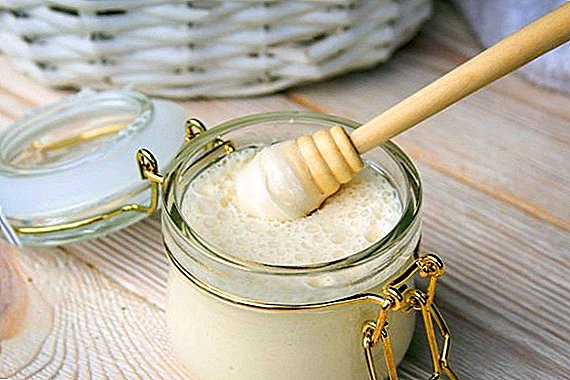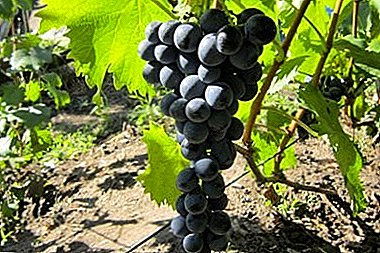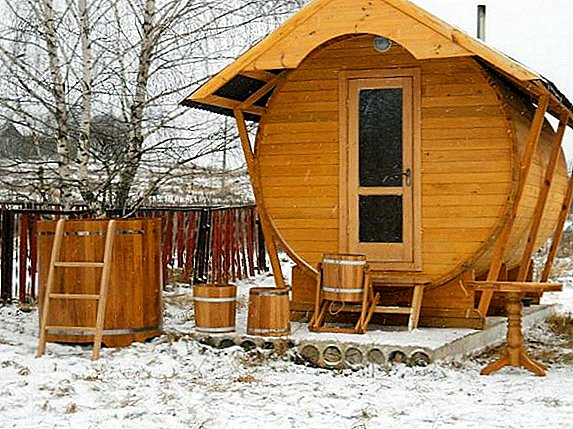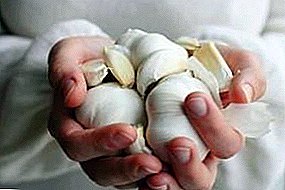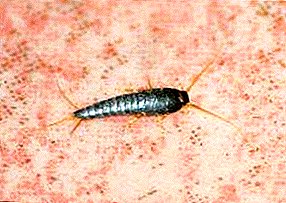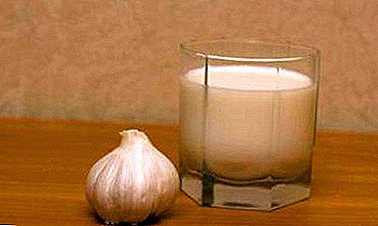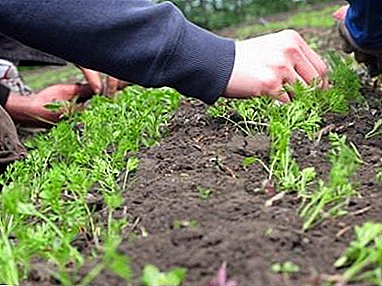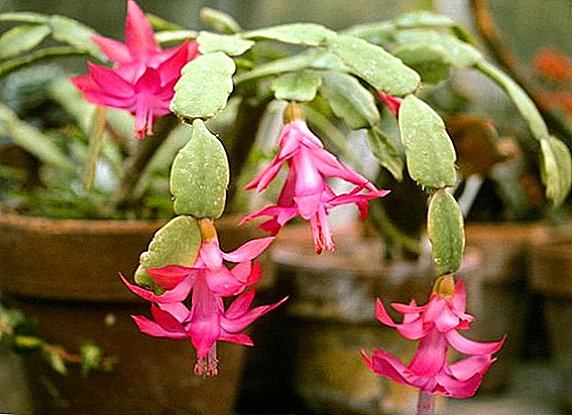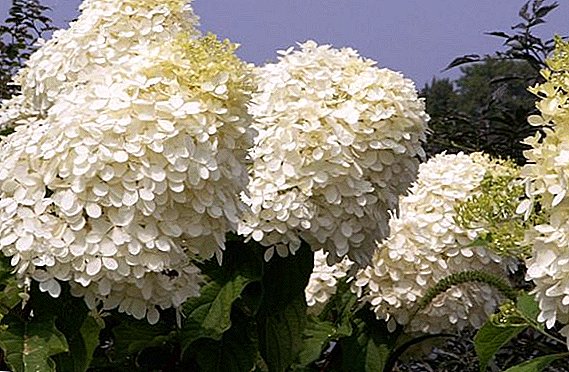 In this article we will introduce you to Phantom hydrangea and give a complete description of planting and caring for it.
In this article we will introduce you to Phantom hydrangea and give a complete description of planting and caring for it.
The shrubs of this truly beautiful plant are a frequent guest in the country beds, and, undoubtedly, many would like to learn more and understand how to properly care and grow hydrangea.
Variety description
The variety of hydrangeas "Phantom" is considered to be one of the most beautiful among other paniculate hydrangeas. It is distinguished not only by its large, rich flowering, but also by its amazing honey aroma, which will attract many insects to itself.
Did you know? Because of the amazing beauty of the bush named after the beautiful princess.Initially paniculate hydrangeas lived in Japan, China and Korea. Also bushes met on the island of Sakhalin. It is because of the place of origin of the plants have excellent resistance to frost. The research and breeding of cultivated varieties of hydrangeas began in the middle of the XVIII century. The priority of the breeders was to preserve the qualities that make it possible to grow these bushes in one place for a long time.
Did you know? If you properly care for him, the bush will live more than 40 years.Hydrangea paniculata "Phantom" is endowed with the main advantages that are inherent in the original ancestor Hydrangea paniculata. This makes it indispensable in gardens with poor soil and helps to grow successfully even in adverse climate conditions.
 Hydrangea is resistant to root diseases that occur when growing on wetlands, and is able to quickly restore vegetative parts after pruning or freezing.
Hydrangea is resistant to root diseases that occur when growing on wetlands, and is able to quickly restore vegetative parts after pruning or freezing.You will be interested to learn more about Annabelle hydrangea.Despite the simplicity in conditions, hydrangeas should choose a lighted place, where it will not touch the direct sunlight. You also need to take care of wind protection. Hydrangea Phantom requires certain conditions of planting and care.
Landing conditions
For planting this hydrangea usually use cuttings or more often cuttings. The pit for planting should be about half a meter and prepare in advance. It is filled with fertile soil, which should contain peat. Optimum acidity can range from low to medium. The seedling is arranged in such a way that the root neck is at ground level. The first time the plant should be generously watered, but not eroding the soil over the roots. If you did everything right, then it will take root in the first two or three weeks. You can determine this by new leaves on the stems.
It is very important to plant the bushes at the right time.
Timing
In the north, hydrangea is planted in early spring. In places with a warm climate prefer autumn planting. It is better to plant the plants in a well-warmed soil, and this is approximately April - May.
But before planting you need to take care of the condition of the soil in which you are going to plant.
Lighting and soil
Although hydrangea is unpretentious enough, there are a few key points. Bushes need light, only the direct sunshine they suffer badly. Strong wind also does not add benefits when growing.  The soil should not just be fertile. Hydrangea requires a soil of a certain acidity - so it will be better to bloom and develop. Therefore, during watering, gardeners often add lemon juice to water.
The soil should not just be fertile. Hydrangea requires a soil of a certain acidity - so it will be better to bloom and develop. Therefore, during watering, gardeners often add lemon juice to water.
Important! To increase the acidity of the soil, you can add brown peat, pine needles or just sawdust. Ash, chalk or lime, on the contrary, will negatively affect acidity.For landing you need to focus on certain points.
Planting technology of hydrangea "Phantom"
Planting hydrangeas requires special skills and skills, as it is necessary to prepare not only the land, but also seedlings. When planting should take into account the acidity and fertility of the soil. The pit for planting also need to be specially prepared.
Preparing a pit for planting a bush
It is necessary to harvest a hole for planting in advance, in about two weeks. You need to dig a hole at least half a meter in length and about 60 centimeters in width. Next, pour into it fertile soil with peat. If soil acidity is too high, use lime or dolomite flour. In case you want to plant a hedge, you should consider that the distance between plants should be up to two and a half meters. To get a fence as early as possible, you can land at a distance of about a meter, but then after a few years you will need to thin out the plants.
In the process of landing, there are also a number of nuances.
Bristle Hydrangea planting pattern
Planting material is extracted with a small lump of soil. Before planting, broken roots and branches are pruned with a little shears. When planting in the center of the fossa, pour a small mound of earth so that the upper part is level with the edges of the fossa. Next, carefully place the roots so that they "look" in different directions.
Important! The root neck should not go deeper than two centimeters, otherwise the hydrangea will develop poorly and grow.The earth must be tamped tightly to avoid voids. In the future, it threatens the drying of the plant. Sapling must be watered well, so that the soil was wet at a depth of up to half a meter.
Now that you have planted your plant, the question arises, how can you continue to care for it so that it grows large and strong. 
Plant Care
When your hydrangea begins to grow, first of all pay attention to its feeding, watering and pruning.
If the plant is not cut in time, then too thick a bush will be quite tight.
You need to water about once every two weeks, but you should follow the soil itself - it should not be completely dry. During watering can feed mineral fertilizer.
Watering
The bush does not depend on watering and is able to grow quietly and dry season. However, in such conditions, flowering will be mild and short-lived. For ideal conditions, hydrangea "Phantom" should be watered regularly. The soil in which it grows must be sufficiently wet. This can be achieved using about 30 liters of water per square meter. In the rainy period, the amount of water is reduced.  The abundance of moisture is not the only need of the plant. All experienced gardeners know that their pets need every way to please fertilizers.
The abundance of moisture is not the only need of the plant. All experienced gardeners know that their pets need every way to please fertilizers.
Top dressing
Hydrangea is insatiable in terms of top dressing, so the soil must be regularly fertilized. Otherwise, the soil will quickly become unusable, since it literally draws out all the nutrients. With the arrival of spring, it is desirable to use top dressing, which is based on nitrogen. For rapid growth in May or June, you can fertilize the soil with humus or use complex fertilizer. In the flowering season of hydrangea is recommended to make mineral fertilizers with the obligatory content of potassium and phosphorus. Be careful with the amount: fertilize no more than once every 15 days. Excessive flowering can lead to oblong branches.
You need to finish feeding in August. This will give the plant time to prepare for pruning.
Trim rules
Standard hydrangea paniculata "Phantom" cut in the fall, as soon as flowering is completed.  This will simultaneously get rid of wilted inflorescences and wrap the soil around the plant for the time of cold weather. Pruning branches produce neatly, like trees, without affecting the skeletal branches. If necessary, you can get rid of weak and thin shoots. New branches can be shortened by 2 or 4 buds.
This will simultaneously get rid of wilted inflorescences and wrap the soil around the plant for the time of cold weather. Pruning branches produce neatly, like trees, without affecting the skeletal branches. If necessary, you can get rid of weak and thin shoots. New branches can be shortened by 2 or 4 buds.
If desired, the bushes can be trimmed in the spring, after the buds are swollen. For the renewal of old plants they are pruned at the root, in young you can leave up to four buds. If cutting the cuttings in the first 4-5 years with high quality and regularly, you can get an amazing little tree.
Important! In the first year of flowering flowers must be cut. This will enable the plant to gain strength and bloom in full force in the coming year.However, before that, your hydrangea will need to survive the winter, but it is not mild in all regions.
Winterhard quality hydrangea "Phantom"
Hydrangea "Phantom" refers to winter-hardy varieties and does not need special insulation.
Important! To further protect the root system from freezing, place peat with leaves or humus around the bush.In especially cold regions, it is possible to completely close the bush. To do this, wrap the plant with insulation and at a distance of 30 centimeters from it, install a frame from the grid. Then fill it with dry foliage. Then everything is covered with a waterproof film.
When your plant becomes strong enough and grows considerably, you can think about how to multiply it yourself at home.
Basic plant propagation rules
Hortensia paniculata can be propagated in three ways: cuttings, branches and division of the bush.
Cuttings are best prepared in advance - in the first month of summer, prior to their lignification. The shoots are left for several days in water, and after they are cut from two sides, leaving 3-4 buds. The lower cut is strongly recommended to treat the growth factor for the roots. Then place the cuttings in pots with soil from a mixture of peat and sand.  Next, seedlings are brought in a special greenhouse. If you don’t have one, simply cover with banks or film to achieve the desired effect. However, plants must be in the shade, preferably in the basement. Rooting occurs in the first few weeks, during this period, you need to carefully water the seedlings, as hydrangea likes moist soil. Planted new plants is recommended in August next when. By the time the cuttings will have strong roots.
Next, seedlings are brought in a special greenhouse. If you don’t have one, simply cover with banks or film to achieve the desired effect. However, plants must be in the shade, preferably in the basement. Rooting occurs in the first few weeks, during this period, you need to carefully water the seedlings, as hydrangea likes moist soil. Planted new plants is recommended in August next when. By the time the cuttings will have strong roots.
Learn more about breeding cuttings of plants such as plumeria, laurel, chrysanthemum, clematis, Brugmancia.When dividing the bush, the plants are dug out in the fall, right after the flowering has ended. Next you need to carefully divide it into three parts. The main condition is that each part must have buds for the subsequent growth of the bush. The roots of the new bushes are slightly shortened, and then planted in a hole. The soil must be fed in advance with mineral and organic fertilizers.
The layers are propagated by hydrangea exclusively in the spring. However, this method of reproduction does not give a guaranteed result. It is conducted as follows:
- Dig a hole no more than 15 centimeters deep.
- Choose the branch closest to the ground, cut the leaves off its tip and peel the bark.
- Next, place it in the prepared hole and cover it with earth on top.
Important! Do not forget about regular watering, it will contribute to the early formation of new roots.Then, when the branch settles down, it is cut at the base of the mother plant. Only after some time the branch can be transplanted, otherwise it may die. Continue to care for the cuttings and, when it is fully strengthened, you can safely move to another place.
 Hortensia "Phantom" - a great decoration of any problem. The plant is unpretentious in the care and reward you for the work of large buds with honey aroma.
Hortensia "Phantom" - a great decoration of any problem. The plant is unpretentious in the care and reward you for the work of large buds with honey aroma.

